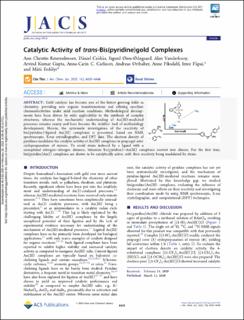| dc.contributor.author | Holta, Ann Christin Reiersølmoen | |
| dc.contributor.author | Csokas, Daniel | |
| dc.contributor.author | Øien-Ødegaard, Sigurd | |
| dc.contributor.author | Vanderkooy, Alan | |
| dc.contributor.author | Gupta, Arvind Kumar | |
| dc.contributor.author | Carlsson, Anna-Carin C. | |
| dc.contributor.author | Orthaber, Andreas | |
| dc.contributor.author | Fiksdahl, Anne | |
| dc.contributor.author | Pàpai, Imre | |
| dc.contributor.author | Erdélyi, Máté | |
| dc.date.accessioned | 2021-02-17T14:06:54Z | |
| dc.date.available | 2021-02-17T14:06:54Z | |
| dc.date.created | 2021-01-22T15:52:58Z | |
| dc.date.issued | 2020 | |
| dc.identifier.citation | Journal of the American Chemical Society. 2020, 142 (13), 6439-6446. | en_US |
| dc.identifier.issn | 0002-7863 | |
| dc.identifier.uri | https://hdl.handle.net/11250/2728720 | |
| dc.description.abstract | Gold catalysis has become one of the fastest growing fields in chemistry, providing new organic transformations and offering excellent chemoselectivities under mild reaction conditions. Methodological developments have been driven by wide applicability in the synthesis of complex structures, whereas the mechanistic understanding of Au(III)-mediated processes remains scanty and have become the Achilles’ heel of methodology development. Herein, the systematic investigation of the reactivity of bis(pyridine)-ligated Au(III) complexes is presented, based on NMR spectroscopic, X-ray crystallographic, and DFT data. The electron density of pyridines modulates the catalytic activity of Au(III) complexes in propargyl ester cyclopropanation of styrene. To avoid strain induced by a ligand with a nonoptimal nitrogen–nitrogen distance, bidentate bis(pyridine)–Au(III) complexes convert into dimers. For the first time, bis(pyridine)Au(I) complexes are shown to be catalytically active, with their reactivity being modulated by strain. | en_US |
| dc.language.iso | eng | en_US |
| dc.publisher | American Chemical Society | en_US |
| dc.rights | Navngivelse 4.0 Internasjonal | * |
| dc.rights.uri | http://creativecommons.org/licenses/by/4.0/deed.no | * |
| dc.title | Catalytic Activity of trans-Bis(pyridine)gold Complexes | en_US |
| dc.type | Peer reviewed | en_US |
| dc.type | Journal article | en_US |
| dc.description.version | publishedVersion | en_US |
| dc.source.pagenumber | 6439-6446 | en_US |
| dc.source.volume | 142 | en_US |
| dc.source.journal | Journal of the American Chemical Society | en_US |
| dc.source.issue | 13 | en_US |
| dc.identifier.doi | 10.1021/jacs.0c01941 | |
| dc.identifier.cristin | 1877398 | |
| dc.description.localcode | This is an open access article published under a Creative Commons Attribution (CC-BY) License, which permits unrestricted use, distribution and reproduction in any medium, provided the author and source are cited. | en_US |
| cristin.ispublished | true | |
| cristin.fulltext | original | |
| cristin.qualitycode | 2 | |

